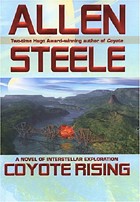
COYOTE RISING:
A Novel of Interstellar Revolution
Allen Steele
Hugo Award-winning author Allen Steele follows up his imaginative novel COYOTE with the sequel, COYOTE RISING. I've read all of Allen Steele's novels and most of his short stories. Why? Because he never disappoints. Steele's stories always have the ring of truth because he populates them with believable characters, fast-paced plots, and technology that is understandable to the average Joe. All of these traits are in abundance in COYOTE RISING.
In the first novel, a group of interstellar colonists hijack a prototype starship named Alabama and flee a right-wing dictatorship to settle on the distant planet Coyote. Coyote is a harsh world with long and bitter winters and dangerous wildlife. The struggle to set up the first human colony on this planet is fraught with peril and makes for a great read. Steele recaps events from COYOTE nicely in COYOTE RISING, but I recommend reading the original first. It's like watching The Empire Strikes Back --- you don't need to see Star Wars to get it, but you will enjoy it more if you do.
In COYOTE, the first settlers fled tyranny on Earth and fought hard to explore the new world and build the settlement of Liberty. But the rulers of Earth have not given up on Coyote. They cannot. A majority of Earth has become uninhabitable, so mankind needs a new home. At the end of COYOTE, more spaceships are sent to Coyote with colonists and soldiers. The original settlers don't take too kindly to these interlopers led by tyrannical colonial governor Matriarch Luisa Hernandez, so they abandon Liberty and set up a new colony.
COYOTE RISING picks up from there, with the newcomers living in the now overcrowded Shuttlefield that has cropped up next to Liberty. Steele's strength is writing about things you actually believe can happen. The colonists are limited in what they can bring to the new world, so they must use the planet's natural resources. Most of the colonists live a brutal frontier life that many modern-day people would find unbearable.
The climate and wildlife on the planet Coyote are bad enough, but the new colonists also must deal with the oppressive Matriarch Hernandez who rules with an iron fist. Many newcomers abandon their miserable situation and join the rebels --- aka, the original colonists Steele introduced to us in COYOTE. Hernandez eventually pushes the rebels too far. Led by Alabama's Captain Robert E. Lee and Coyote's first explorer, Carlos Montero, the rebels lead a revolution to free Coyote from the new oppressive government. Steele is a talented action scene writer. They unfold at logical points and help move the plot. They aren't there only for the sake of action. He puts you into the minds of the characters and the heat of battle with just enough of the right details.
The novel is chock full of fascinating characters and vivid descriptions of this alien world. However, I did have one small problem. Both novels began as short stories serialized in Asimov's Science Fiction magazine. Throughout both novels, it feels like you're reading a series of short stories with a common backdrop. Readers are reintroduced to characters they have met before and some of the previous action is recapped several times --- making redundancy and repetition an issue. However, this is a minor flaw and I still thoroughly enjoyed COYOTE RISING. In fact, on some level it was interesting to see the same event explained from different characters' viewpoints.
I read most of COYOTE RISING in a small Laundromat not far from my apartment in Los Angeles. The novel whisked me away from the dreary setting and transported me to the world of Coyote. I was so completely lost in the story of old characters like Carlos Montero and new characters like prophet Zoltan Shirow that I didn't hear the buzzer when my laundry was done. So if you're looking for a good read that will let you escape this world for a new one, then pick up COYOTE RISING.
--- Reviewed by Sean Doorly, a Los Angeles-based freelance writer (http://www.doorly.com)
Reviewed for BookReporter.com